| Article ID | Journal | Published Year | Pages | File Type |
|---|---|---|---|---|
| 6474305 | Fuel | 2017 | 11 Pages |
Turbulent flames in the moderate or intense low oxygen dilution (MILD) combustion regime have previously exhibited less susceptibility to lift-off than conventional autoignitive flames in a jet-in-hot-coflow (JHC) burner. This has been demonstrated through laser-based diagnostics and examination of CH* chemiluminescence. New experimental observations are presented of turbulent flames of natural gas, ethylene and blends of the two fuels, in coflows with temperatures from 1250-1385Â K and oxygen concentrations from 3-11% (vol./vol.). Zero- and one-dimensional simulations, as well as turbulent flame modelling, are used to explain the trends seen experimentally with different coflows and fuels. Numerical simulations using simplified batch reactors and opposed-flow flames demonstrate that blending of methane and ethylene fuels is most significant near 1100Â K. Near this temperature, pure ethylene exhibits a transition between high and low temperature ignition pathways. Further analyses show that a 1:1 methane/ethylene blend behaves more like ethylene near MILD combustion conditions, and more like methane in conventional autoignition conditions. Two-dimensional modelling results of the turbulent flames are then discussed and explained in the context of the simplified reactor results. The flames confined by the lean flammability-limit in the coflow and high strain-rates in jet shear layer, in agreement with previous work using a semi-empirical jet model. The two-dimensional modelling is additionally able to qualitatively replicate the trends in lift-off height, with normalised heat release rate profiles reproducing, and serving to explain, the effects seen in experimental campaigns.
